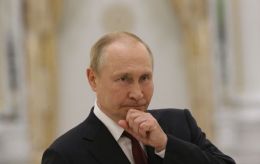Toretsk under attack: Where Russia intensifies assaults and how front line moves
 Ukrainian soldier (photo: Getty Images)
Ukrainian soldier (photo: Getty Images)
Russian troops do not cease attempts to fully occupy the Donetsk region. Meanwhile, the Armed Forces of Ukraine continue to hold a buffer zone in Kursk. Why it is needed, what is happening near Toretsk, and what is the situation on the Dnipro islands — in the material by RBC-Ukraine.
Takeaways
-
What priority has Russia chosen for its spring-summer offensive campaign?
-
Why is landing troops on the islands in the Dnipro a difficult task?
-
What is happening in the Kursk region, which was supposedly “cleared” of the Armed Forces of Ukraine?
-
Why can't Russian troops advance on Zaporizhzhia?
Russia insists that Ukraine must give it four regions, which Moscow has already written into the constitution. At the same time, the enemy cannot reach the borders of the four regions by military means. Therefore, today, Russian troops have concentrated all their forces to capture the Donetsk region fully.
Judging by what is happening on the line of combat, the priority of the Russians’ spring-summer campaign is the Sloviansk-Kramatorsk direction. In case of success, this would allow them to reach the borders of the Donetsk region, presenting a victory to their society. At the same time, the Russian military is trying to drive the Armed Forces of Ukraine out of the Kursk region despite repeatedly declaring the liberation of Kursk.
The hottest direction
The main priority for the Russians for the next three months of the offensive will be precisely Sloviansk, Kramatorsk, and Kostyantynivka, and military experts are convinced. The Institute for the Study of War (ISW) claims that Russia’s military command has redeployed units of several army corps from the Kurakhove area and the occupied areas of the Zaporizhzhia region to the Toretsk direction.
According to geolocation maps, Russian troops attacked and advanced southwest of Toretsk in Myrne. ISW recorded reports of unit redeployments for the first time at the end of March 2025. However, the main relocation of troops was carried out by command on April 21 — during the first so-called “ceasefire” that Vladimir Putin declared for Easter. At that time, Russian forces managed to amass forces for further attacks on Toretsk.
“They concentrated their forces on the most vulnerable section of the front — at the junction of combat operations of our formations, which are operating in the Pokrovsk agglomeration and, accordingly, conducting combat in the Toretsk area. The enemy struck at this junction quite successfully and has achieved success,” noted former spokesman of the General Staff of the Armed Forces of Ukraine, Vladyslav Seleznov, in a comment to RBC-Ukraine.
Russian Telegram channels also report that Russian Armed Forces units are engaged in combat in Stara Mykolaivka and Oleksandropil, simultaneously conducting clearances near Kalynove. All these settlements are located southwest of Toretsk.
The Russians also carried out several attacks toward Myrnohrad, which is located east of Pokrovsk, using armored vehicles. “This is dangerous — while we were fighting the enemy in the Udachne area, we didn’t notice its advance east of Myrnohrad. There, the enemy has advanced south of Kostyantynivka, and this is a serious challenge,” added Seleznov.
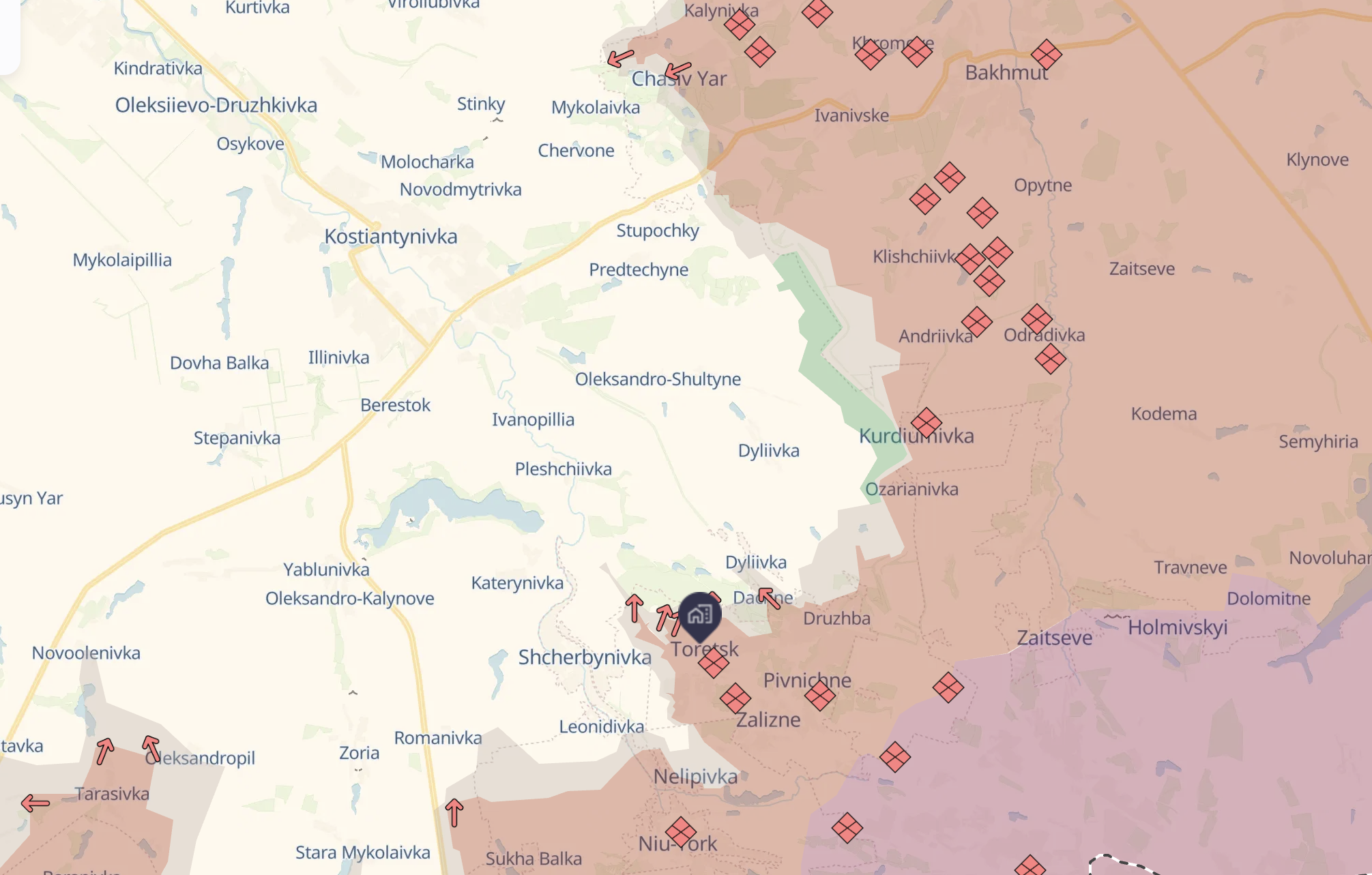
(Screenshot of DeepState map showing the advance of Russian troops in Toretsk and around Chasiv Yar)
The attack on Myrnohrad may be part of Russia’s plan to encircle Pokrovsk. The Institute for the Study of War also suggests that the enemy has recently shifted attention to Novopavlivka in attempts to reach the border between the Dnipropetrovsk and Donetsk regions. The movements of the Russians also indicate that they want to reach the southwest of Toretsk to further advance toward Kostyantynivka.
Essentially, to reach the borders of the Donetsk region — which is one of the goals of Russia’s special military operation — Russian forces are forming three strike footholds. One is in the Toretsk area toward Kostyantynivka, the second from Chasiv Yar to Kostyantynivka, and the third from Lyman to Sloviansk and Kramatorsk.
“If the enemy manages to begin combat operations along these three directions, the Russian General Staff will consider that the first part of its plan has been implemented,” added Seleznov.
For the Russians, Toretsk, according to experts, is the key to Kostyantynivka, as it is located in front of it and opens the way further to Kramatorsk and Sloviansk. Therefore, today, the enemy will focus on the direction from Toretsk to Pokrovsk.
Also, the fact that the Sloviansk-Kramatorsk direction is a priority for the Russians today is evidenced by the number of combat clashes. Of the 100% of strikes per day, almost half were in the Donetsk region.
In addition, Russian troops have approached the Dnipropetrovsk region and are currently 3–5 km from its border. Considering that Putin immediately wrote any occupied territory into the Russian constitution, concerns about such a development are justified. On the other hand, conducting combat there will clearly be difficult for the enemy.
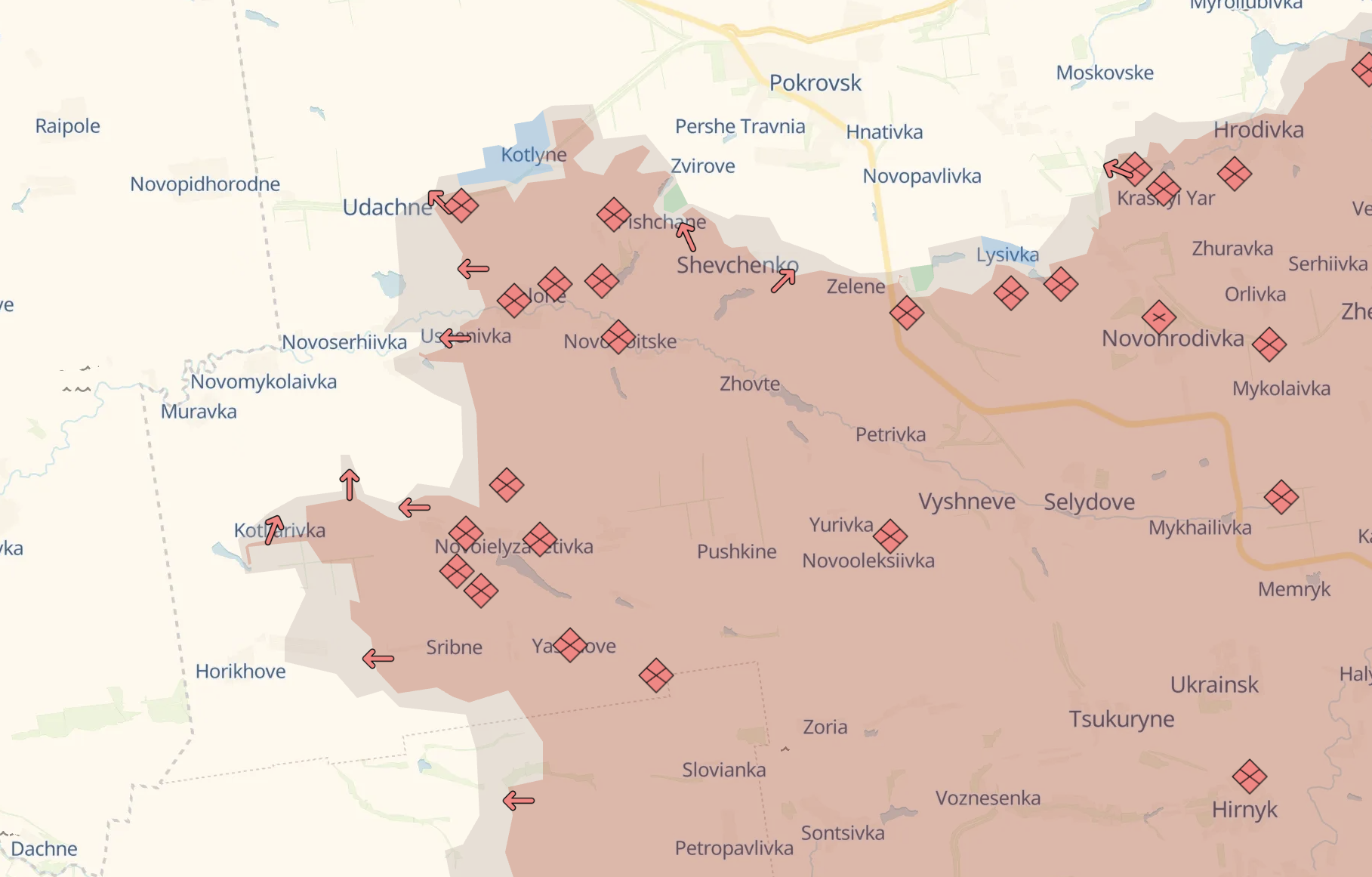
(Screenshot of DeepState map showing advance of Russian troops toward Pokrovsk and Myrnohrad)
“Penetration into Dnipropetrovsk region — well, it’s more of an informational pretext. But from a military point of view, there’s no benefit to this at all. Up to 20 km of open battlefield. How will the Russians ensure logistics for themselves? There’s absolutely no logic in this,” noted Seleznov.
Kherson, landing force, and islands
Combat operations in the Kherson region also do not cease, but they resemble not so much an assault as rather an attempt to gain a foothold on the islands located on the Dnipro River. Recently, according to the officer of the "Omega" National Guard diving unit Yurii Tkachuk, the enemy attempted to land a landing force and establish firing positions on the islands.
In reality, Russian troops constantly attempt to land and gain a foothold on the islands between the banks of the Kherson region, but they suffer defeat. However, so do the Ukrainian military. The thing is that the islands along the river represent a very inconvenient point for consolidation.
"On these islands, there is relatively little vegetation; there are bushes, thickets, and so on. It is very difficult to dig in there because the water table is low. You stick a shovel into the ground and water appears in the hole. That is, it is practically impossible to dig any kind of dugout or trench," notes military expert Pavlo Narozhnyi in a comment to RBC-Ukraine.
The enemy constantly tries to carry out such assault actions and somewhat intensify them. However, in order to carry out large-scale actions using hundreds of boats, it is necessary to ensure secrecy, and in conditions where the islands are regularly shelled, this is virtually impossible.
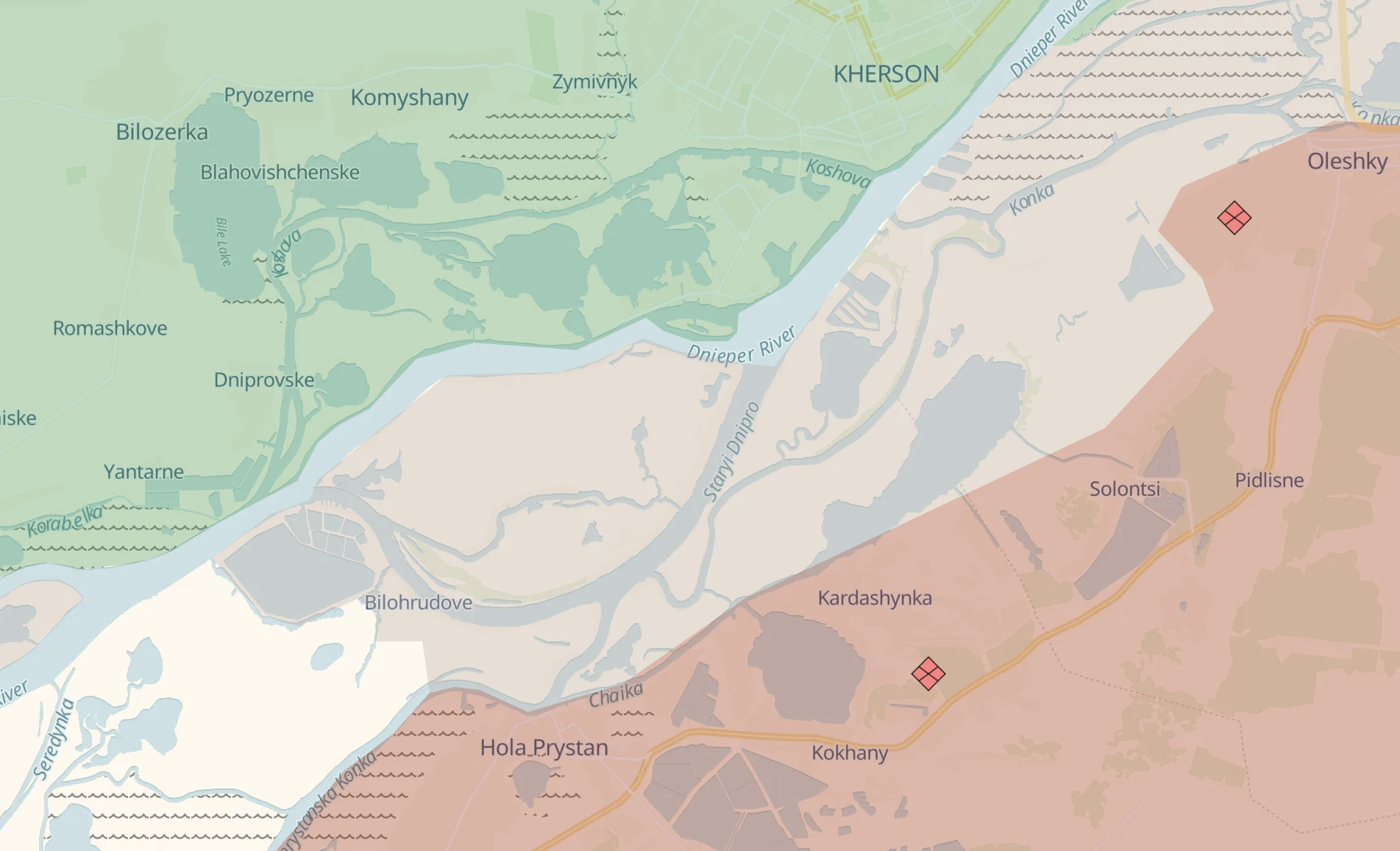
(Screenshot of DeepState map showing islands on the Dnipro between the banks of the Kherson region)
"Such attempts by the enemy lead to nothing because the Defense Forces of Ukraine destroy the enemy and stop their attempts. These attempts look like a one-way ticket. Those who come under fire remain on the islands—if they survive. They are dropped food and water, and they stay there for some time until they are destroyed," notes spokesperson of Operational Command "South" Vladyslav Voloshyn in a comment to RBC-Ukraine.
For some time, the enemy even used boats as observation posts so as not to remain on the islands and not become a living target for artillery and drones. In addition, the entire river mouth is well observed, so crossing the Dnipro is virtually impossible due to the height of the bank and good visibility. The only purpose for which the islands are used and for which troops may temporarily land on them is reconnaissance. Therefore, small sabotage and reconnaissance groups enter there—there can be no talk of a large landing force.
"Even if there are some isolated attempts, they cannot consolidate there — it’s a matter of logistics. How, under such conditions, can you create a permanent pontoon crossing? There is no possibility. We have our artillery, aviation, our drone operators. We will simply destroy it," added Seleznov.
Therefore, what happens on the islands is, as they call it, operational combat work. Ukrainian soldiers periodically land on them, and Russian ones periodically land on them. But it is difficult and pointless to gain a foothold there. Another matter is the Kinburn Spit, which the Russians have occupied and used as a firing point, shelling from Ochakiv and other settlements in the Mykolaiv region.
From the spit, the enemy has the ability to control the mouths of the Southern Bug and the Dnipro. Attacks on nearby settlements do not go unanswered, and periodically, the Russians have to replenish equipment supplies on the spit. But this does not fundamentally affect the overall situation on the front.
29 km of the Kursk region
Despite numerous statements by the Russians that the Kursk region has been cleared and the AFU is no longer there, in fact, this is not true. As of today, Ukrainian troops control about 29 km of territory in the direction of Sudzha. And there, combat actions do not cease.
On May 5, Russian "war correspondents" reported attacks in the area of the village of Tiotkino, which is located in the Glushkovsky district of the Kursk region. According to them, Ukrainian troops carried out a series of attacks in this area, using demining equipment to breakthrough the Russian minefields. At the same time, the ISW notes that Ukrainian forces are trying to "isolate Russian units near Tiotkino," including by striking a drone command post and eliminating 20 Russian soldiers. The destruction of the post was also confirmed by the head of the Center for Countering Disinformation, Andrii Kovalenko.
"For understanding: Tiotkino in the Kursk region has been used since 2022 as a UAV school. There, Russians were first trained on Mavics, then taught how to drop munitions, including on our civilians, then on FPV. Well, and now there was a command post for Russian UAVs, which carried out attacks on Sumy region. The key word is 'was,' noted Kovalenko.
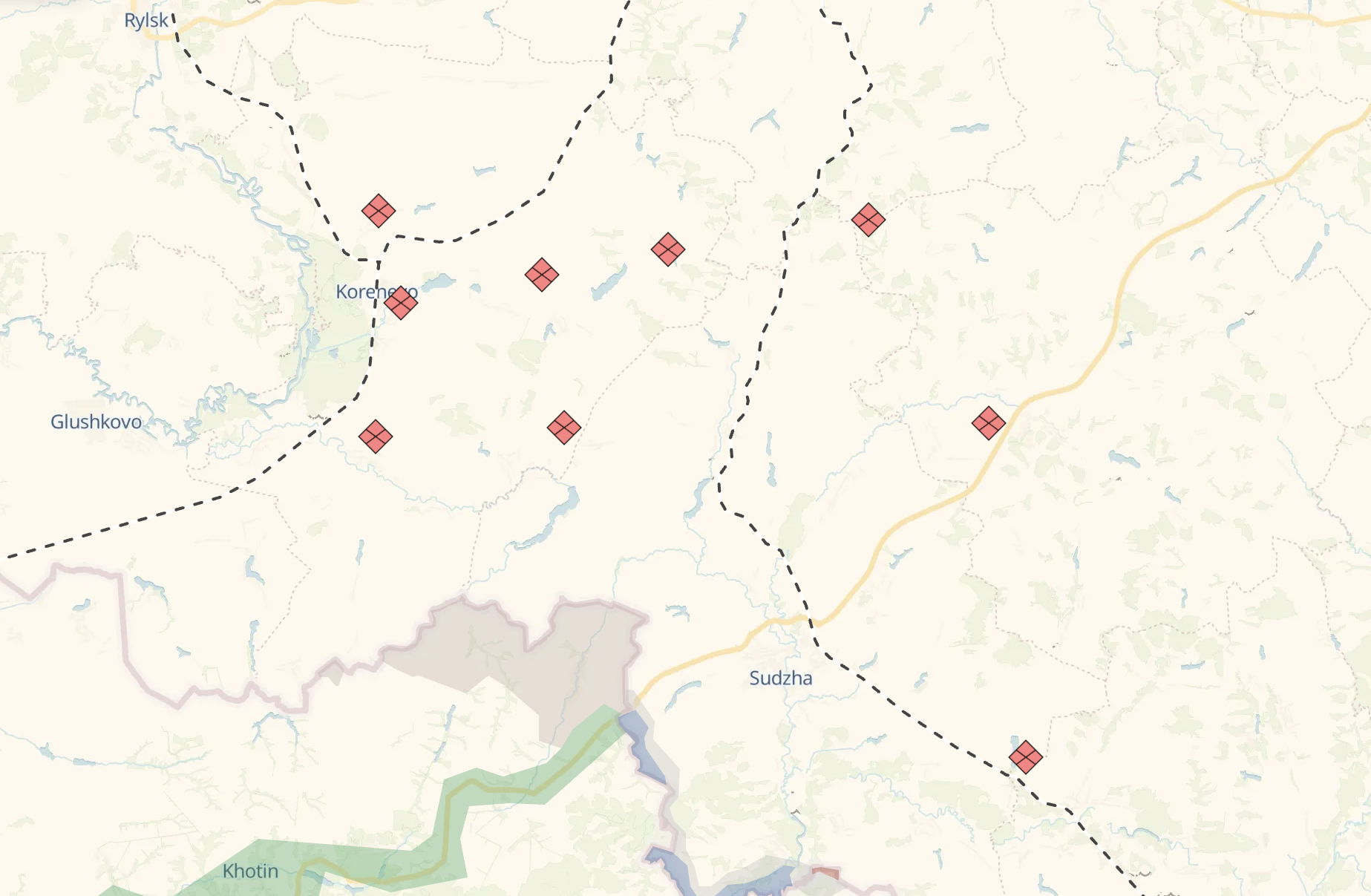
Screenshot of DeepState map showing the situation in the Kursk region, where the AFU established a presence
At the same time, the Russians continue attempts to establish themselves in the Sumy region, where the border villages are virtually destroyed. Ukrainian Defense Forces regularly detect and eliminate sabotage and reconnaissance groups trying to advance into the rear and create a "sanitary zone".
Following regular attacks from the border villages of Basivka and Novenke, from which almost nothing remains, a so-called gray zone has formed in this territory, which in fact makes no sense to assault.
"If we assault this forest belt, it will mean heavy losses for us. And what will we get as a result? Novenke is a completely destroyed village — no single intact building is left. Well, we’ll reach the state border post, we can take a nice photo there. So there’s not much point in this. This gray zone exists," added Narozhnyi.
Hard-to-reach Zaporizhzhia
In the direction of Zaporizhzhia, Russian troops continue to fight. But, apparently, the capture of the regional center today is not their main goal. Having concentrated on Toretsk and Pokrovsk, the enemy even transferred part of its forces from the Zaporizhzhia direction.
At the same time, according to experts, for the Russians, an offensive on Zaporizhzhia looks logical. The city itself in the Russian information space has long been considered "theirs." In addition, Zaporizhzhia is a large industrial center and a major logistical base of the Armed Forces of Ukraine. But to advance, the Russians need to solve a number of tasks, the main one being logistics in the southern direction, with which they have problems.
"They need to supply a huge amount of ammunition, and they can do this through Crimea. But we are constantly striking there. The second option is to go through the sea, which is also under our control. There is a railway that leads to Melitopol, but it is all under fire, all the bases there are known, it will not be easy for them," notes Pavlo Narozhny.
Today, Russian troops have determined their priority and transferred most of their resources. This indicates that they cannot advance simultaneously in several directions in different regions.
